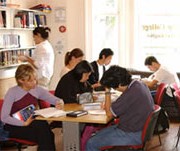How to Choose Your Study Abroad Program
When choosing to study abroad there are many things that go through your head – is it worth it? Will I really learn the language? Can I get enough course credit? All these questions and anxieties are completely normal and ultimately important to your decision making.
The first thing you should do if you are looking to study abroad outside of your home University program is to meet with your school advisor about what you want to do and what you want to achieve. The most important part of your education abroad is that you are rewarded not only in the experience but for the work you did while you were there.
Every University has a different list of criteria for issuing US credit for the courses you take abroad, so before booking a course you should always consult with your advisor on how many hours you’ll need to complete and what type of courses you’ll need to take to not only get the experience you want but the course credit you need.
By confirming the amount of hours you need to complete and having a detailed list of the documents you need from the institution aboard to submit to your home University, you will be well on your way to making your study abroad experience happen. Having this information at the beginning of your search will help you determine which program in which location is the best for you and allow you to make the best decision more efficiently.
Once you have that information, it comes down to how much time you can commit to studying abroad and how many credits you ultimately want to receive. Do you have a week, a summer, or a whole semester? Do you need 12 credits or just 3? Here’s a breakdown of types of study abroad programs and what will work best according to your goals:
Winter and Spring Break
If you want to make the most of the few weeks you have off for winter or spring break there are plenty of options around the globe. The best option for this short period of time would be an Intensive Language Course or a Combined Language Course. These courses are 30 lessons (25-30 hours) per week and focus on advancing your language skills as quickly as possible in the short amount of time that you are there. The standard rule is that 45 contact hours equals 3 credits, so take 2 weeks of the Intensive or Combined course and there’s a solid chance your University will issue you the credits for your time abroad
Summer
Doing a study abroad program in the summer is a great way to make sure you take enough hours of a course to gain the credit you need while still allowing you a varied amount of programs to choose from. You can take a Spanish and Mayan History Course in Merida, a Language and Culture course in Paris or Aix, a German and Music course in Vienna, or a Japanese and Traditional Culture course in Fukuoka, Japan. These courses will not only advance your language skills in a short time period but give you extra elements to the course to provide your home university with good reason for issuing you more course credits.
Semester
If you’re going abroad for an entire semester, it’s most important that you focus on a program that offers you variety to allow you to get the most credits for your time abroad. The reality is that if you’re looking for a whole semester of credit, taking just a language course won’t be enough. Focus on the programs that offer language courses as well as cultural courses so you can get a well rounded academic semester. A good example of this is the semester program in Malaga, which offers a Spanish course as well as courses on Spanish history, literature, economy, and media. Taking this type of program will not only make your time more enjoyable, but will make it much easier to transfer credit upon your return when you are able to present varied course syllabi and assignments for approval.
Ultimately, the options are endless, but the more organized you are about your goals with study abroad, the more likely you are to gain the credit you need and make the most out of the experience.
Still need advice? Feel free to contact us for information on possibilities and programs.





